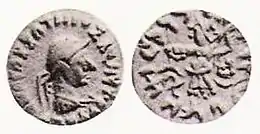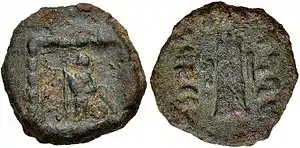Apollophane
Apollophane Soter (règne autour de 35 – ) est un roi indo-grec qui règne dans l’Est et le centre du Pendjab, région actuellement partagée entre l’Inde et le Pakistan.

Face: Profil casqué du roi. Légende en grec: BASILEOS SOTEROS APOLLOPHANOU "Du roi sauveur Apollophanes".
Rev: Pallas avec aegis et foudre. Légende en kharoshthi: MAHARAJASA TRATARASA APALAVINASA "Roi sauveur Apollophanes".

Règne
On ne connaît pas grand-chose sur ce roi, sinon par les pièces de monnaie qu’il a laissé. Apollophane frappe des drachmes en argent de mauvais aloi. Il n'utilise qu’un seul monogramme d’une faible qualité artistique, indice d’un pouvoir peu étendu.
La datation de son règne vers 35 – 25 av. J.-C. est faite par Osmund Bopearachchi, mais RC Senior propose approximativement les mêmes dates. Auparavant, les spécialistes comme Ahmed Hasan Dani (en), W. W. Tarn et A. K. Narain ont daté le règne d'Apollophane bien plus tôt, mais le style et le lieu de découverte de ses monnaies montrent clairement que ce roi appartenait aux derniers rois du royaume oriental indo-grec, peu de temps avant son invasion par les nomades indo-scythes.
| Rois Gréco-Bactriens et Indo-Grecs, et leurs territoires d'après Osmund Bopearachchi (1991) | ||||||||||||
| Territoires/ dates | Bactriane Occidentale | Bactriane Orientale | Paropamisades | Arachosie | Gandhara | Punjab occidental | Punjab oriental | Mathura | Inde centrale | |||
|---|---|---|---|---|---|---|---|---|---|---|---|---|
| 326-325 AEC | Campagnes d'Alexandre le Grand | Empire Nanda | ||||||||||
| 305-281 AEC | Empire séleucide Séleucos Ier Nicator |
Empire maurya Chandragupta Maurya | ||||||||||
| 281-261 AEC | Antiochos Ier Sôter Fondation d'Aï Khanoum (280) |
|||||||||||
| 261-246 AEC | Antiochos II Théos | Ashoka (268-232) | ||||||||||
| 255-239 AEC | Royaume gréco-bactrien | |||||||||||
| Diodote Ier | ||||||||||||
| 239-223 AEC | Diodote II |
|||||||||||
| 240-225 AEC | Antiochos |
|||||||||||
| 230-200 AEC | Euthydème Ier |
|||||||||||
| 200–190 AEC | Royaumes indo-grecs | Empire Shunga | ||||||||||
| Démétrios Ier | ||||||||||||
| 190–180 AEC | Euthydème II |
Agathoclès |
Pantaléon |
|||||||||
| 185–170 AEC | Antimaque Ier |
|||||||||||
| 180–160 AEC | Apollodote Ier |
|||||||||||
| 175–170 AEC | Démétrios II |
|||||||||||
| 160–155 AEC | Antimaque II |
|||||||||||
| 170–145 AEC | Eucratide Ier |
Plaque d'Aï Khanoum | ||||||||||
| 155–130 AEC | Ménandre Ier |
Attaque de la vallée du Gange[M 1] | Attaque de Pataliputra[M 2] - [M 3] - [M 4] - [M 1] | |||||||||
| 145–140 AEC | Invasions Yuezhi Chute d'Aï Khanoum (145) |
Eucratide II Platon | ||||||||||
| 145–130 AEC | Hélioclès Ier | |||||||||||
| 130–120 AEC | Zoïlos I (en) |
Agathocléia |
Inscription Yavanarajya (en): "Règne des Indo-Grecs à Mathura" |
Yavanas (en) à: Udayagiri (en) | ||||||||
| 120–110 AEC | Lysias Anicétus (en) |
Straton Ier (en) |
Yavanas à: Bharhut | |||||||||
| 110–100 AEC | Antialkidès |
Hélioclès II (en) |
Pilier d'Héliodoros | |||||||||
| 100 AEC | Polyxénos Epiphanes Soter (en) |
Démétrios III Aniketos (en) |
Satavahanas Yavanas à: Sanchi | |||||||||
| 100–95 AEC | Philoxénus Anicetus (en) | |||||||||||
| 95–90 AEC | Diomédès Soter (en) |
Amyntas Nikator (en) |
Épandre (en) | |||||||||
| 90 AEC | Theophilos (roi) (en) |
Peukolaos (en) |
Thrason (en) | |||||||||
| 90–85 AEC | Nicias (en) |
Ménandre II (en) |
Artémidore | |||||||||
| 90–70 AEC | Hermaeus (en) |
Archebius (en) | ||||||||||
| Invasions Yuezhi | Mauès (en) (Indo-Scythe) | |||||||||||
| 75–70 AEC | Telephos (en) |
Apollodote II (en) |
Dynastie Mitra (en) Dynastie Datta (en) | |||||||||
| 65–55 AEC | Hippostrate (en) |
Dionysios (en) | ||||||||||
| 55–35 AEC | Azes Ier (en) (Indo-Scythe) | Zoilos II (en) | ||||||||||
| 55–35 AEC | Apollophane | |||||||||||
| 25 AEC – 10 EC | Straton II (en) Straton III (en) | |||||||||||
| Gondopharès Ier (Indo-Parthe) | Rajuvula (en) (Indo-Scythe) | |||||||||||
| Kujula Kadphisès (Empire kouchan) | Bhadayasa (en) (Indo-Scythe) | Sodasa (en) (Indo-Scythe) | Inscriptions de Yavanas à: Karla Manmodi (en) Nasik (en) Shivneri | |||||||||
- Bopearachchi, Monnaies gréco-bactriennes et indo-grecques, p 82-83
- The Geography of India: Sacred and Historic Places Educational Britannica Educational p.156
- Shane Wallace Greek Culture in Afghanistan and India: Old Evidence and New Discoveries 2016, p.210
- Rocher, Ludo (1986), The Puranas, p.254: "The Yuga Purana (en) is important primarily as a historical document. It is a matter-of-fact chronicle [...] of the Magadha empire, down to the breakdown of the Sungas and the arrival of the Sakas. It is unique in its description of the invasion and retirement of the Yavanas in Magadha."
Notes et références
Voir aussi
Bibliographie
- W.W. Tarn, The Greeks in Bactria and India, Cambridge University Press.
- Prof. Ahmed Hasan Dani, The Bactrian and Indus Greeks, Lahore Museum.
- Dr. A.K. Narain, The Indo-Greeks - Revisited and Supplemented, BR Publishing Corporation.
- Osmund Bopearachchi, Monnaies Gréco-Bactriennes et Indo-Grecques, Bibliothèque Nationale de France.
Liens externes
Source de la traduction
- (en) Cet article est partiellement ou en totalité issu de l’article de Wikipédia en anglais intitulé « Apollophanes » (voir la liste des auteurs).